2001 CADILLAC SEVILLE steering
[x] Cancel search: steeringPage 167 of 371

2-100
TRANS HOT IDLE ENGINE - 112: This message
indicates that the transaxle fluid in your vehicle is too
hot. Stop and allow your vehicle to idle until it cools
down or until this message is removed.
TRUNK OPEN
- 24: This message indicates that the
trunk is open when the ignition is on.
TURN SIGNAL ON
- 20: This message is a reminder,
after driving about a mile, that you have the turn signal
on. A multiple chime will also sound when this message
is displayed.
VEHICLE OVERSPEED
- 52: This message is
displayed when the vehicle speed exceeds a certain limit
as required by some export countries. A continuous
chime will also sound when this message is displayed.
Vehicle Programming and
Personalization Features
(If Equipped)
If your vehicle is equipped with personalization,
you can program certain features to a preferred setting
for up to two people. If your vehicle does not have
personalization, then some of the features on your
vehicle have been programmed for all drivers.
On all vehicles, certain features such as climate control
settings, radio preset settings, exterior lighting at
unlock, remote lock and unlock confirmation and
automatic door locks have already been programmed
for your convenience. If the vehicle is equipped with
Personalization, then the seat position, steering column
position (if equipped) and the outside mirror positions
can also be programmed. The navigation screen
preferences (if equipped) will remain at the last
set position.
Page 168 of 371
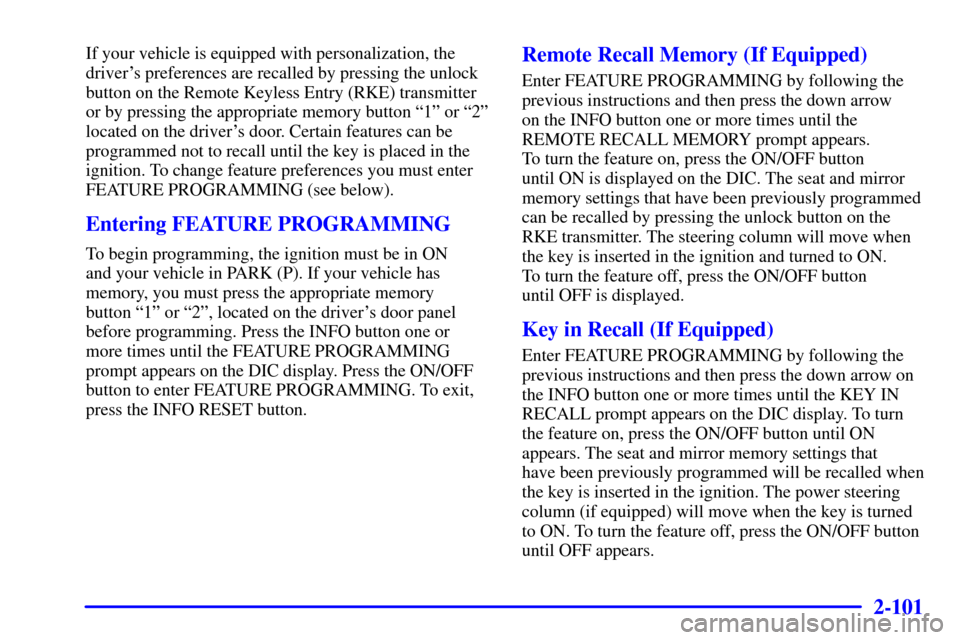
2-101
If your vehicle is equipped with personalization, the
driver's preferences are recalled by pressing the unlock
button on the Remote Keyless Entry (RKE) transmitter
or by pressing the appropriate memory button ª1º or ª2º
located on the driver's door. Certain features can be
programmed not to recall until the key is placed in the
ignition. To change feature preferences you must enter
FEATURE PROGRAMMING (see below).
Entering FEATURE PROGRAMMING
To begin programming, the ignition must be in ON
and your vehicle in PARK (P). If your vehicle has
memory, you must press the appropriate memory
button ª1º or ª2º, located on the driver's door panel
before programming. Press the INFO button one or
more times until the FEATURE PROGRAMMING
prompt appears on the DIC display. Press the ON/OFF
button to enter FEATURE PROGRAMMING. To exit,
press the INFO RESET button.
Remote Recall Memory (If Equipped)
Enter FEATURE PROGRAMMING by following the
previous instructions and then press the down arrow
on the INFO button one or more times until the
REMOTE RECALL MEMORY prompt appears.
To turn the feature on, press the ON/OFF button
until ON is displayed on the DIC. The seat and mirror
memory settings that have been previously programmed
can be recalled by pressing the unlock button on the
RKE transmitter. The steering column will move when
the key is inserted in the ignition and turned to ON.
To turn the feature off, press the ON/OFF button
until OFF is displayed.
Key in Recall (If Equipped)
Enter FEATURE PROGRAMMING by following the
previous instructions and then press the down arrow on
the INFO button one or more times until the KEY IN
RECALL prompt appears on the DIC display. To turn
the feature on, press the ON/OFF button until ON
appears. The seat and mirror memory settings that
have been previously programmed will be recalled when
the key is inserted in the ignition. The power steering
column (if equipped) will move when the key is turned
to ON. To turn the feature off, press the ON/OFF button
until OFF appears.
Page 169 of 371
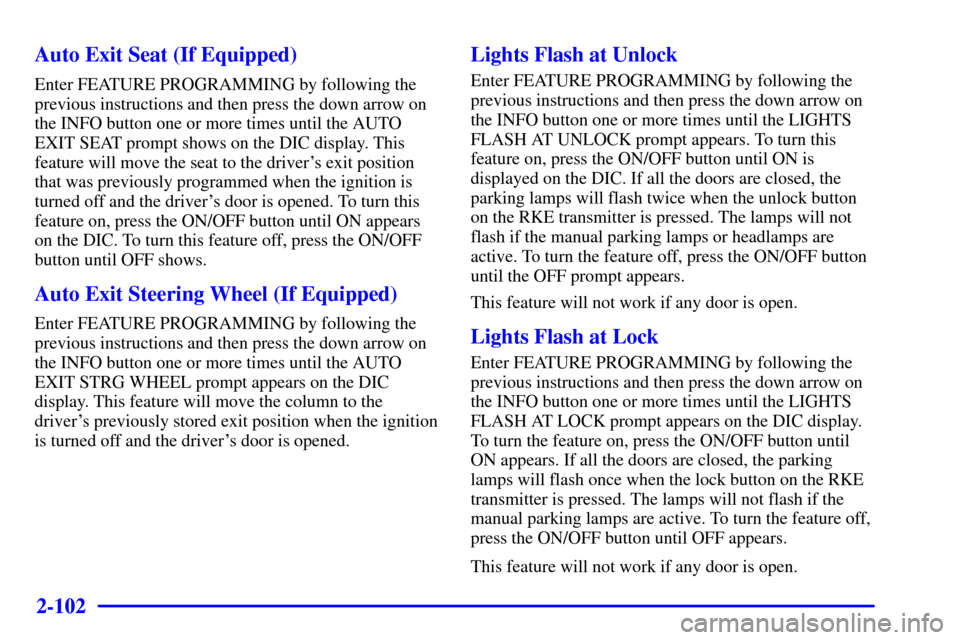
2-102
Auto Exit Seat (If Equipped)
Enter FEATURE PROGRAMMING by following the
previous instructions and then press the down arrow on
the INFO button one or more times until the AUTO
EXIT SEAT prompt shows on the DIC display. This
feature will move the seat to the driver's exit position
that was previously programmed when the ignition is
turned off and the driver's door is opened. To turn this
feature on, press the ON/OFF button until ON appears
on the DIC. To turn this feature off, press the ON/OFF
button until OFF shows.
Auto Exit Steering Wheel (If Equipped)
Enter FEATURE PROGRAMMING by following the
previous instructions and then press the down arrow on
the INFO button one or more times until the AUTO
EXIT STRG WHEEL prompt appears on the DIC
display. This feature will move the column to the
driver's previously stored exit position when the ignition
is turned off and the driver's door is opened.
Lights Flash at Unlock
Enter FEATURE PROGRAMMING by following the
previous instructions and then press the down arrow on
the INFO button one or more times until the LIGHTS
FLASH AT UNLOCK prompt appears. To turn this
feature on, press the ON/OFF button until ON is
displayed on the DIC. If all the doors are closed, the
parking lamps will flash twice when the unlock button
on the RKE transmitter is pressed. The lamps will not
flash if the manual parking lamps or headlamps are
active. To turn the feature off, press the ON/OFF button
until the OFF prompt appears.
This feature will not work if any door is open.
Lights Flash at Lock
Enter FEATURE PROGRAMMING by following the
previous instructions and then press the down arrow on
the INFO button one or more times until the LIGHTS
FLASH AT LOCK prompt appears on the DIC display.
To turn the feature on, press the ON/OFF button until
ON appears. If all the doors are closed, the parking
lamps will flash once when the lock button on the RKE
transmitter is pressed. The lamps will not flash if the
manual parking lamps are active. To turn the feature off,
press the ON/OFF button until OFF appears.
This feature will not work if any door is open.
Page 180 of 371
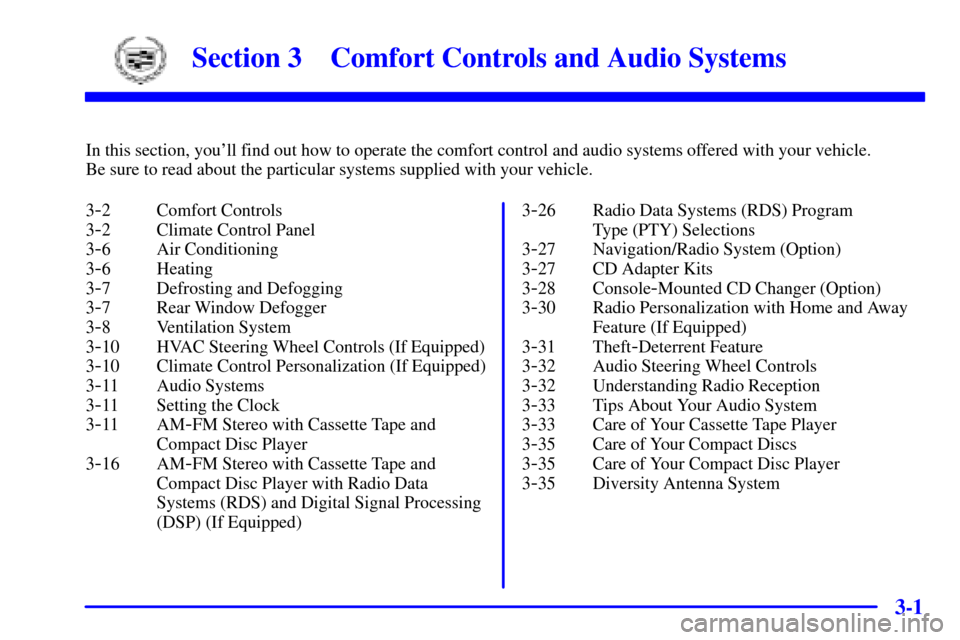
3-
3-1
Section 3 Comfort Controls and Audio Systems
In this section, you'll find out how to operate the comfort control and audio systems offered with your vehicle.
Be sure to read about the particular systems supplied with your vehicle.
3
-2 Comfort Controls
3
-2 Climate Control Panel
3
-6 Air Conditioning
3
-6 Heating
3
-7 Defrosting and Defogging
3
-7 Rear Window Defogger
3
-8 Ventilation System
3
-10 HVAC Steering Wheel Controls (If Equipped)
3
-10 Climate Control Personalization (If Equipped)
3
-11 Audio Systems
3
-11 Setting the Clock
3
-11 AM-FM Stereo with Cassette Tape and
Compact Disc Player
3
-16 AM-FM Stereo with Cassette Tape and
Compact Disc Player with Radio Data
Systems (RDS) and Digital Signal Processing
(DSP) (If Equipped)3
-26 Radio Data Systems (RDS) Program
Type (PTY) Selections
3
-27 Navigation/Radio System (Option)
3
-27 CD Adapter Kits
3
-28 Console-Mounted CD Changer (Option)
3
-30 Radio Personalization with Home and Away
Feature (If Equipped)
3
-31 Theft-Deterrent Feature
3
-32 Audio Steering Wheel Controls
3
-32 Understanding Radio Reception
3
-33 Tips About Your Audio System
3
-33 Care of Your Cassette Tape Player
3
-35 Care of Your Compact Discs
3
-35 Care of Your Compact Disc Player
3
-35 Diversity Antenna System
Page 189 of 371

3-10 HVAC Steering Wheel Controls
(If Equipped)
Some heating and cooling
controls can be adjusted at
the steering wheel. Other
touch controls operate some
audio controls. See ªAudio
Steering Wheel Controlsº in
the Index.
FAN: Press the up arrow on the control to increase
the fan speed and the down arrow to decrease fan speed.
TEMP: Press the up arrow on the control to increase the
temperature and the down arrow to decrease temperature.
Climate Control Personalization
(If Equipped)
With this feature, your vehicle will recall the latest
climate control settings as adjusted the last time your
vehicle was operated. These settings include the set
temperatures for driver and passenger, air conditioning,
mode and fan speed. (This feature does not recall
recirculation or defrost modes.) This feature allows two
different drivers to store and recall their own climate
control settings. The settings recalled by the climate
control system are determined by which Remote
Keyless Entry (RKE) transmitter (ª1º or ª2º) was used
to enter the vehicle. The number on the back of the RKE
transmitter corresponds to driver 1 or to driver 2. After
any button is pressed on the RKE transmitter or the key
is placed in the ignition, the climate control settings will
automatically adjust to where they were last set. The
settings can also be changed by briefly pressing buttons
1 or 2 located on the driver's door.
Page 211 of 371
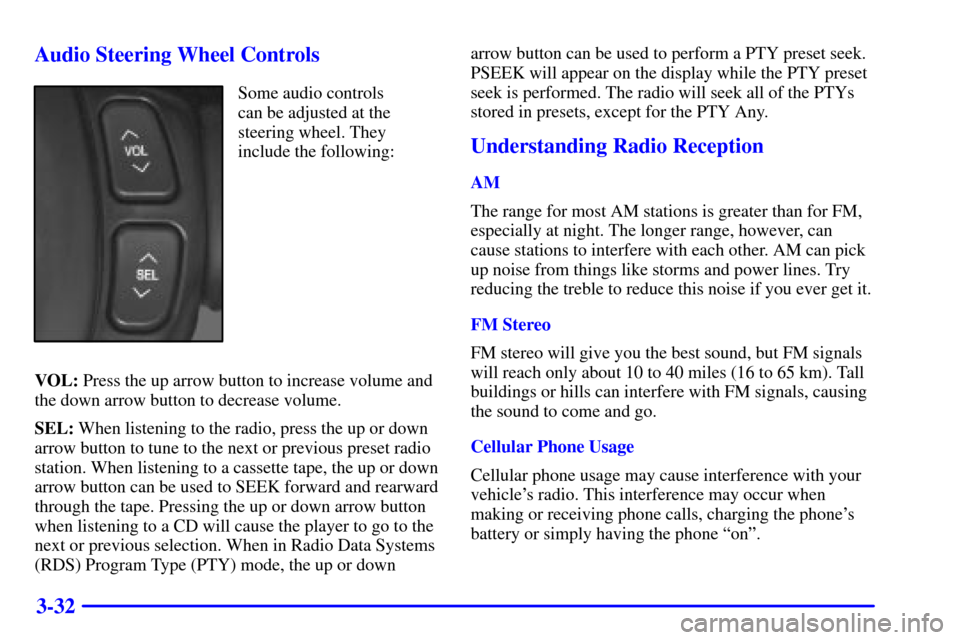
3-32 Audio Steering Wheel Controls
Some audio controls
can be adjusted at the
steering wheel. They
include the following:
VOL: Press the up arrow button to increase volume and
the down arrow button to decrease volume.
SEL: When listening to the radio, press the up or down
arrow button to tune to the next or previous preset radio
station. When listening to a cassette tape, the up or down
arrow button can be used to SEEK forward and rearward
through the tape. Pressing the up or down arrow button
when listening to a CD will cause the player to go to the
next or previous selection. When in Radio Data Systems
(RDS) Program Type (PTY) mode, the up or downarrow button can be used to perform a PTY preset seek.
PSEEK will appear on the display while the PTY preset
seek is performed. The radio will seek all of the PTYs
stored in presets, except for the PTY Any.
Understanding Radio Reception
AM
The range for most AM stations is greater than for FM,
especially at night. The longer range, however, can
cause stations to interfere with each other. AM can pick
up noise from things like storms and power lines. Try
reducing the treble to reduce this noise if you ever get it.
FM Stereo
FM stereo will give you the best sound, but FM signals
will reach only about 10 to 40 miles (16 to 65 km). Tall
buildings or hills can interfere with FM signals, causing
the sound to come and go.
Cellular Phone Usage
Cellular phone usage may cause interference with your
vehicle's radio. This interference may occur when
making or receiving phone calls, charging the phone's
battery or simply having the phone ªonº.
Page 215 of 371
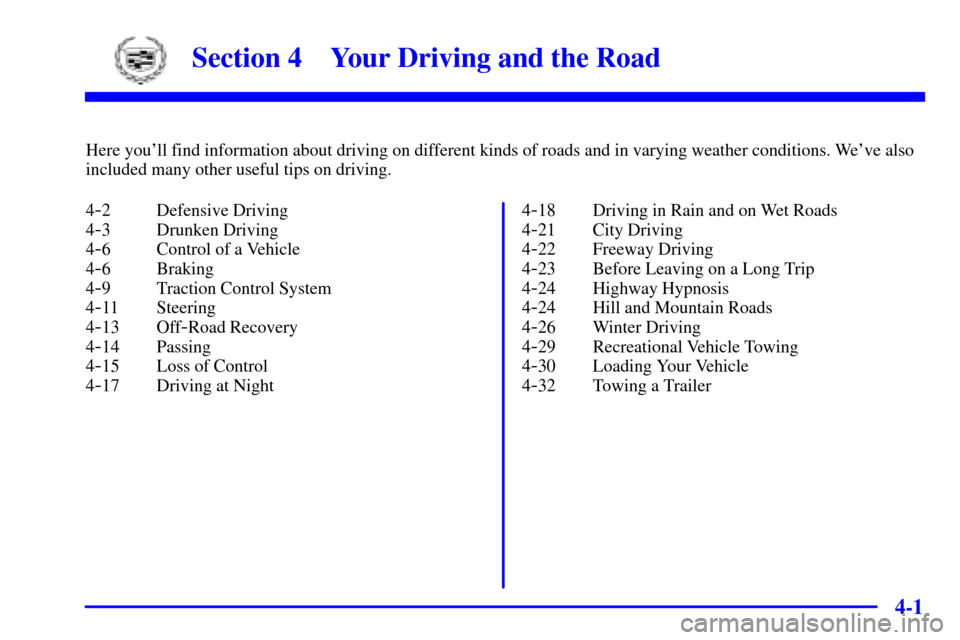
4-
4-1
Section 4 Your Driving and the Road
Here you'll find information about driving on different kinds of roads and in varying weather conditions. We've also
included many other useful tips on driving.
4
-2 Defensive Driving
4
-3 Drunken Driving
4
-6 Control of a Vehicle
4
-6 Braking
4
-9 Traction Control System
4
-11 Steering
4
-13 Off-Road Recovery
4
-14 Passing
4
-15 Loss of Control
4
-17 Driving at Night4
-18 Driving in Rain and on Wet Roads
4
-21 City Driving
4
-22 Freeway Driving
4
-23 Before Leaving on a Long Trip
4
-24 Highway Hypnosis
4
-24 Hill and Mountain Roads
4
-26 Winter Driving
4
-29 Recreational Vehicle Towing
4
-30 Loading Your Vehicle
4
-32 Towing a Trailer
Page 220 of 371

4-6
Control of a Vehicle
You have three systems that make your vehicle go where
you want it to go. They are the brakes, the steering and
the accelerator. All three systems have to do their work
at the places where the tires meet the road.
Sometimes, as when you're driving on snow or ice, it's easy
to ask more of those control systems than the tires and
road can provide. That means you can lose control of your
vehicle. Also see ªTraction Control Systemº in the Index.
Braking
Braking action involves perception time and
reaction time.
First, you have to decide to push on the brake pedal.
That's perception time. Then you have to bring up
your foot and do it. That's reaction time.
Average reaction time is about 3/4 of a second.
But that's only an average. It might be less with one
driver and as long as two or three seconds or more with
another. Age, physical condition, alertness, coordination
and eyesight all play a part. So do alcohol, drugs and
frustration. But even in 3/4 of a second, a vehicle
moving at 60 mph (100 km/h) travels 66 feet (20 m).
That could be a lot of distance in an emergency, so
keeping enough space between your vehicle and others
is important.
And, of course, actual stopping distances vary greatly
with the surface of the road (whether it's pavement or
gravel); the condition of the road (wet, dry, icy); tire
tread; the condition of your brakes; the weight of the
vehicle and the amount of brake force applied.